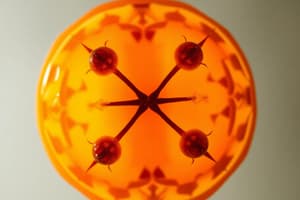Podcast
Questions and Answers
What occurs during the S phase of the cell cycle?
What occurs during the S phase of the cell cycle?
- Proteins are synthesized.
- Cell growth occurs.
- DNA is replicated. (correct)
- Cells undergo cytokinesis.
Which phase of the cell cycle directly precedes mitosis?
Which phase of the cell cycle directly precedes mitosis?
- G2 Phase (correct)
- G1 Phase
- S Phase
- Apoptosis
What is the main purpose of checkpoints in the cell cycle?
What is the main purpose of checkpoints in the cell cycle?
- To monitor stages and prevent errors. (correct)
- To facilitate cell death.
- To enhance protein synthesis.
- To ensure DNA is not replicated.
How are new cells produced through asexual reproduction?
How are new cells produced through asexual reproduction?
Which of the following correctly describes binary fission in prokaryotes?
Which of the following correctly describes binary fission in prokaryotes?
What defines the difference between a zygote and cells produced by mitosis?
What defines the difference between a zygote and cells produced by mitosis?
What is the primary role of cytokinesis in the cell cycle?
What is the primary role of cytokinesis in the cell cycle?
Which checkpoint ensures that everything is ready for DNA replication?
Which checkpoint ensures that everything is ready for DNA replication?
What forms the cleavage furrow in animal cells during cytokinesis?
What forms the cleavage furrow in animal cells during cytokinesis?
What happens during telophase?
What happens during telophase?
Which molecules act to regulate the cell cycle?
Which molecules act to regulate the cell cycle?
What is the consequence of losing control over the cell cycle?
What is the consequence of losing control over the cell cycle?
Which phase follows anaphase in the cell cycle?
Which phase follows anaphase in the cell cycle?
What is the role of spindle fibers during mitosis?
What is the role of spindle fibers during mitosis?
During which phase of the cell cycle does chromatin condense into visible chromosomes?
During which phase of the cell cycle does chromatin condense into visible chromosomes?
What is the significance of the metaphase checkpoint?
What is the significance of the metaphase checkpoint?
What role does the p53 gene play in normal cell function?
What role does the p53 gene play in normal cell function?
What is the primary consequence of a defective p53 gene in cancer cells?
What is the primary consequence of a defective p53 gene in cancer cells?
How does cancer development relate to cell division control?
How does cancer development relate to cell division control?
Which statement accurately describes necrosis compared to apoptosis?
Which statement accurately describes necrosis compared to apoptosis?
What effect do mutations have on cancer cells during DNA replication?
What effect do mutations have on cancer cells during DNA replication?
What happens to the communication between cells in tumor formation?
What happens to the communication between cells in tumor formation?
What triggers the start of the cell division process?
What triggers the start of the cell division process?
Which phase of the cell cycle involves the synthesis of proteins and organelles necessary for division?
Which phase of the cell cycle involves the synthesis of proteins and organelles necessary for division?
What is the correct order of the phases in mitosis?
What is the correct order of the phases in mitosis?
Which of the following cells does NOT typically undergo mitosis?
Which of the following cells does NOT typically undergo mitosis?
What does the M phase of the cell cycle represent?
What does the M phase of the cell cycle represent?
During which phase of the cell cycle is DNA replicated?
During which phase of the cell cycle is DNA replicated?
What is the role of the G1 phase in the cell cycle?
What is the role of the G1 phase in the cell cycle?
What is karyokinesis commonly referred to?
What is karyokinesis commonly referred to?
Flashcards are hidden until you start studying
Study Notes
Introduction
- New cells are needed for growth, repair, and replacement of damaged cells.
- New cells are produced by two different types of reproduction: asexual reproduction and sexual reproduction.
- Asexual reproduction: one cell divides into two identical cells; examples include mitosis (in eukaryotes) and binary fission (in bacteria).
- Sexual reproduction: two cells (an egg and a sperm) are joined to produce a new cell (zygote) that is not identical to the parent cells; example is meiosis.
Cell Division
- Prokaryotes (Binary fission):
- Prokaryotes have a single circular DNA molecule.
- This DNA molecule replicates and each copy is attached to the cell membrane at different positions.
- The cell pulls apart, separating the replicated and original DNA molecules.
- Two identical daughter cells are formed.
- Eukaryotic Cells:
- Cell division occurs when there is a need for new cells (growth, damage, etc.)
- When a cell grows too large, nutrient and waste exchange becomes difficult.
- The division process starts when the cell reaches the appropriate size and has enough protein and energy (ATP) stores.
Cell Cycle
- Represents the different stages from the moment a cell is divided into two distinct daughter cells until they are dividing themselves into new cells.
- Divided into three phases: G1, S, G2, and M.
- Interphase (G1, S, and G2 phases):
- G1 (Primary Growth Phase):
- Cell grows to appropriate size for division.
- Increases its supply of proteins needed for division and number of organelles like mitochondria and ribosomes.
- S (Synthesis Phase):
- DNA amount doubles.
- Chromosomes replicate, forming two sister chromatids.
- G2 (Secondary Growth Phase):
- 2nd growth phase after DNA duplication.
- All cell structures needed for division are made (e.g., centrioles).
- Proteins and organelles needed for division are synthesized.
- G1 (Primary Growth Phase):
- M (Mitosis) Phase:
- Division of the nucleus.
- Happens only in eukaryotes.
- Some cells, like nerve and brain cells, do NOT undergo mitosis.
- C (Cytokinesis) Phase:
- The physical process of cell division that divides the cytoplasm of a parental cell into two daughter cells.
- After mitosis, the cytoplasm of the newly formed cells is separated by the aid of actin and myosin contractile ring, which forms a cleavage furrow.
Mitosis Stages
- Prophase:
- Chromatin condenses into chromosomes.
- Nucleolus and nuclear membrane disappear.
- Mitotic spindle forms from centrioles.
- Metaphase:
- Chromosomes attached to kinetochore fibers are lined up along the cell equator.
- Each pole has a whole set of original genes.
- Anaphase:
- Spindle fibers pull sister chromatids apart at their centromeres.
- Telophase:
- Chromosomes reappear as chromatin (uncondensed).
- Nuclear envelope starts to form.
- Nucleolus is visible.
- Spindle breaks apart.
Regulation of Cell Cycle
- Aims to control cell cycle to prevent uncontrolled division of cells.
- Regulatory molecules involved are called cyclins and cyclin-dependent kinases (CDK).
- Cyclin (regulatory subunit) and CDK (catalytic subunit) form a heterodimer that phosphorylates and activates or deactivates target proteins.
- Checkpoints of Cell Cycle are used to monitor and regulate the progress of the cell cycle, ensuring necessary processes are completed and DNA damage is repaired.
- G1 Checkpoint: Ensures everything is ready for DNA replication.
- G2 Checkpoint: Ensures the cell is ready for mitosis.
- Metaphase Checkpoint: Ensures the cell is ready to complete cell division.
Uncontrolled Cell Cycle: Tumor Formation
- Uncontrolled cell division is a hallmark of tumor formation.
- A damaged/defective p53 gene causes loss of information needed to respond to control signals.
- Cancer cells with defective p53 do not respond to cell cycle controlling signals, resulting in uncontrolled division.
Normal Cell vs. Cancer Cell
- Normal Cell:
- DNA is replicated properly.
- Chemical signals start and stop the cell cycle.
- Cells communicate with each other to prevent overcrowding.
- Cancer Cell:
- Mutations occur in the DNA when it is replicated.
- Chemical signals that start and stop the cell cycle are ignored.
- Cells do not communicate with each other, leading to tumor formation.
Cancer: Failure of Cell Division Control
- Cancer is essentially a failure of cell division control, causing unrestrained, uncontrolled tissue growth.
- p53 gene plays a key role in the G1/S checkpoint.
- p53 protein halts cell division if it detects damaged DNA.
- All cancers have to shut down p53 activity.
Cell Death
- Necrosis (Unregulated Cell Death): Death of most or all of the cells in an organ or tissue due to disease, injury, or failure of the blood supply.
- Apoptosis (Regulated Cell Death): An energy-dependent programmed cell death for removal of unwanted individual cells.
Necrosis vs. Apoptosis
- Necrosis involves swelling of the cell and rupture of the cell membrane, releasing cellular contents into the surrounding area, potentially causing inflammation.
- Apoptosis involves a cascade of cellular events that lead to the dismantling of the cell without releasing cellular contents, minimizing inflammation or damage to surrounding cells.
Apoptosis in Physiologic Situations
- About 100,000 cells are produced every second by mitosis and a similar number die by apoptosis in the human body.
- Apoptosis during Embryogenesis:
- Morphogenesis (Eliminates excess cells): Removal of unnecessary cells between fingers and toes.
- Apoptosis during Metamorphosis:
- Eliminates cells no longer needed as an organism undergoes a change in form (example: tadpole to frog).
Apoptosis in Adults
- Tissue Remodeling (eliminates cells no longer needed):
- Virgin Mammary Gland: Apoptosis occurs during late pregnancy and lactation and again during involution (when the gland returns to its non-pregnant state).
- Prostate Gland: Apoptosis is regulated by testosterone levels.
Apoptosis and Disease
- Too Much Apoptosis:
- Tissue Atrophy: Diminished size and function of an organ or tissue due to loss of cells.
- Neurodegeneration: Progressive loss of structure and function of neurons, leading to neurological disorders.
- Too Little Apoptosis:
- Hyperplasia: Abnormal increase in the number of cells in an organ or tissue.
- Athersclerosis: Buildup of plaque in arteries, often leading to heart disease.
Studying That Suits You
Use AI to generate personalized quizzes and flashcards to suit your learning preferences.




